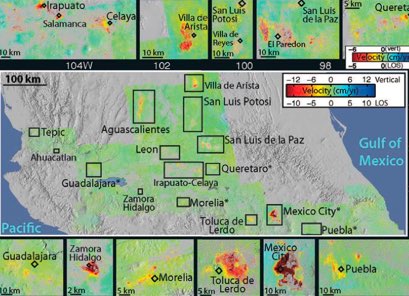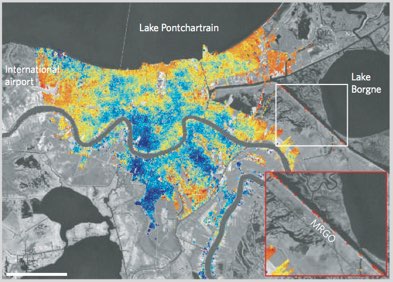Miami Beach

Land subsidence can pose major hazards, in particular in coastal regions because of sea level rise. Estelle Chaussard conducted a survey of subsidence on the Indonesian islands of Sumatra, Java and Bali using ALOS InSAR. She identified 9 locations with significant subsidence and concluded that ground water extraction by industrial users is the main driver for subsidence. In coastal Jakarta subsidence occurs at astonishing rates of >20 cm/yr. See our RSE paper.
Central and Western Indonesia

Land subsidence can pose major hazards, in particular in coastal regions because of sea level rise. Estelle Chaussard conducted a survey of subsidence on the Indonesian islands of Sumatra, Java and Bali using ALOS InSAR. She identified 9 locations with significant subsidence and concluded that ground water extraction by industrial users is the main driver for subsidence. In coastal Jakarta subsidence occurs at astonishing rates of >20 cm/yr. See our RSE paper.
Central Mexico

A land subsidence survey of Central Mexico shows how widespread subsidence in this country is. Subsidence is is most cases due to ground water extraction. See this RSE paper by Estelle Chaussard and colleagues.
New Orleans, Lousiana

The flooding of New Orleans after it was hit by Hurricane Katrina in 2005 was one of the largest and costliest disasters in the history of the U.S. Following the disaster we conducted a study on land subsidence, which showed that most of the city is subsiding at a rate of ~0.5 cm/yr with some parts as rapidly as 2 cm/yr. This extrapolates to up to 2 m of subsidence within a century, which is not good news for a city in parts already below sea level.
Las Vegas, Nevada

Land subsidence at rates of 5 cm/yr due to ground water extraction was a big problem in Las Vegas in the 1990s. Our initial study revealed the spatial extend of subsidence. We then investigated the spatial and temporal subsidence pattern and their causes in more detail (Hoffmann et al., 2001; Bell et al., 2002). We revisited revisited this topic a few years later using a much larger data set and found that subsidence was largely arrested (Bell et al., 2008). It looks that the authorities took notice of our work and implemented measures to prevent further subsidence.



 Land subsidence can pose major hazards, in particular in coastal regions because of sea level rise. Estelle Chaussard conducted a survey of subsidence on the Indonesian islands of Sumatra, Java and Bali using ALOS InSAR. She identified 9 locations with significant subsidence and concluded that ground water extraction by industrial users is the main driver for subsidence. In coastal Jakarta subsidence occurs at astonishing rates of >20 cm/yr. See our RSE paper.
Land subsidence can pose major hazards, in particular in coastal regions because of sea level rise. Estelle Chaussard conducted a survey of subsidence on the Indonesian islands of Sumatra, Java and Bali using ALOS InSAR. She identified 9 locations with significant subsidence and concluded that ground water extraction by industrial users is the main driver for subsidence. In coastal Jakarta subsidence occurs at astonishing rates of >20 cm/yr. See our RSE paper.



